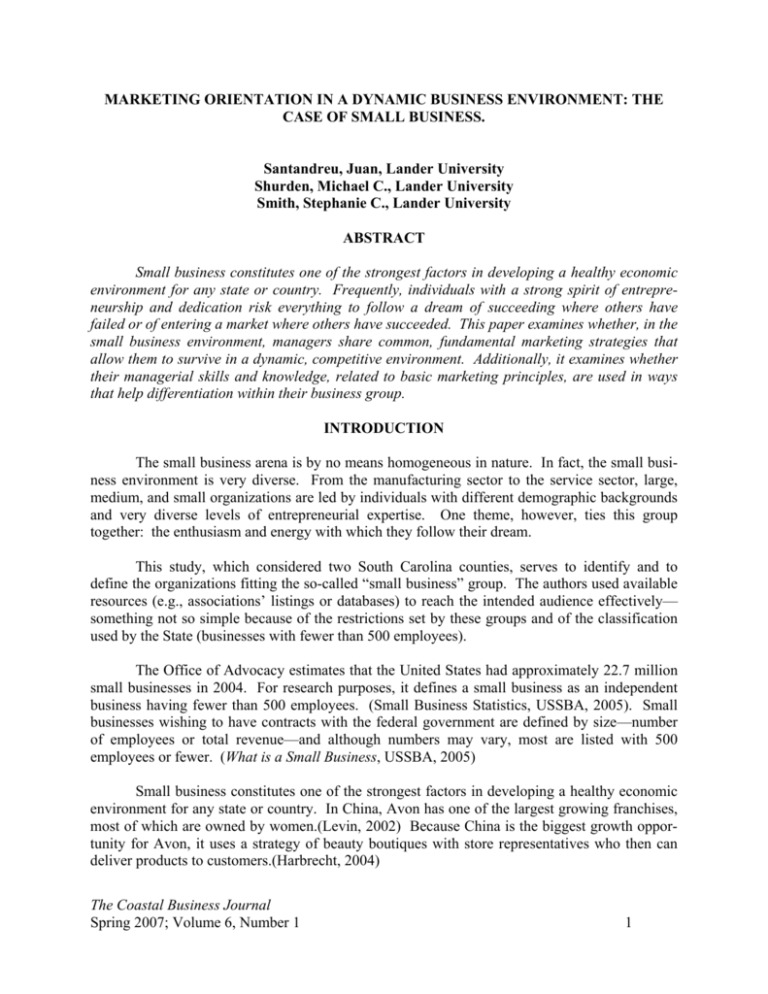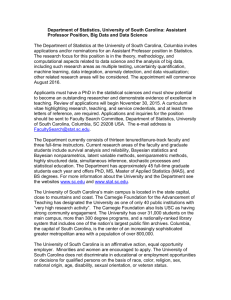MARKETING ORIENTATION IN A DYNAMIC
advertisement

MARKETING ORIENTATION IN A DYNAMIC BUSINESS ENVIRONMENT: THE CASE OF SMALL BUSINESS. Santandreu, Juan, Lander University Shurden, Michael C., Lander University Smith, Stephanie C., Lander University ABSTRACT Small business constitutes one of the strongest factors in developing a healthy economic environment for any state or country. Frequently, individuals with a strong spirit of entrepreneurship and dedication risk everything to follow a dream of succeeding where others have failed or of entering a market where others have succeeded. This paper examines whether, in the small business environment, managers share common, fundamental marketing strategies that allow them to survive in a dynamic, competitive environment. Additionally, it examines whether their managerial skills and knowledge, related to basic marketing principles, are used in ways that help differentiation within their business group. INTRODUCTION The small business arena is by no means homogeneous in nature. In fact, the small business environment is very diverse. From the manufacturing sector to the service sector, large, medium, and small organizations are led by individuals with different demographic backgrounds and very diverse levels of entrepreneurial expertise. One theme, however, ties this group together: the enthusiasm and energy with which they follow their dream. This study, which considered two South Carolina counties, serves to identify and to define the organizations fitting the so-called “small business” group. The authors used available resources (e.g., associations’ listings or databases) to reach the intended audience effectively— something not so simple because of the restrictions set by these groups and of the classification used by the State (businesses with fewer than 500 employees). The Office of Advocacy estimates that the United States had approximately 22.7 million small businesses in 2004. For research purposes, it defines a small business as an independent business having fewer than 500 employees. (Small Business Statistics, USSBA, 2005). Small businesses wishing to have contracts with the federal government are defined by size—number of employees or total revenue—and although numbers may vary, most are listed with 500 employees or fewer. (What is a Small Business, USSBA, 2005) Small business constitutes one of the strongest factors in developing a healthy economic environment for any state or country. In China, Avon has one of the largest growing franchises, most of which are owned by women.(Levin, 2002) Because China is the biggest growth opportunity for Avon, it uses a strategy of beauty boutiques with store representatives who then can deliver products to customers.(Harbrecht, 2004) The Coastal Business Journal Spring 2007; Volume 6, Number 1 1 In the US, “… small businesses employ about half of the private sector work force, produce about half of private sector output, fill niche markets, innovate, and contribute to the competition in free markets.” (USSBA, Reports Room, 2006). Small businesses represent more than 99.7 percent of all employers and employ more than half of all private sector employees. (USSBA, 2003) From 1995 to 2003, self-employment in the US increased by 8.2 percent to a total of 15 million self-employed people. “Women represented half of the increase; their share of self-employment was up from 33.1 to 34.2 percent.” A greater increase occurred in African American self-employment from 1995 to 2003—an increase by 20.3 percent over the period. (USSBA, Reports Room, 2006). Individuals inspired by strong spirit of entrepreneurship and dedication may risk everything they have to focus on a dream of succeeding where others have failed or of joining an area of business that is already successful. Connie Glazer states that the potential for making money inspires male entrepreneurs, but that women are driven by the wish to control their own lives. (Glazer and Smalley, 2000) In South Carolina, small businesses have been instrumental in the creation of new jobs that provide work opportunities in general and for women and minorities in particular, thus improving the economic health of the state. In 1999, small businesses accounted for over 726,000 of South Carolina’s 1,561,727 employees or 46.5 percent. By 2002, small businesses represented 97.2 percent of the businesses in the state. (“2002 Small Business Profile,” 2002). The US Census Bureau reported that in 1997 minority-owned businesses represented 11.8 percent of total businesses in South Carolina. (Business Quick Facts, 2003.) One of every 18 women in the US owns a business, (Clarkin, 2002). By 2004, South Carolina had 84,535 privately held businesses that were 51% or more owned by women—27.4% of all privately held businesses in the state. These businesses generated nearly $18 billion in sales and employed 149,865 people. (Center for Women’s Business Research, 2004) The small business environment is very diverse. From the manufacturing sector to the service sector, large, medium, and small organizations are led by individuals with different demographic backgrounds and very diverse levels of entrepreneurial expertise. One theme that ties this group together is the enthusiasm and energy with which they follow their dream. Many opportunities for help and consultation in marketing and management are available to small businesses, nationally and in the state. For example, nationally, the SBA offers a plethora of business development materials and websites; SCORE (Consultants for Small Businesses) offers the expertise of retired executives from offices all over the US; many sites are specifically designed to help women and minorities. In South Carolina, OSMBA, The Governor's Office of Small and Minority Business Assistance, has as its mission “…to promote the interest of small and minority businesses as a part of the free enterprise system, thereby enhancing economic growth and development in South Carolina.” (OSMBA, 2003) The South Carolina Women’s Business Center provides a wide range of resources and is the only center in the US offering assistance to women in starting up manufacturing businesses. (SCMEP 2006) The official web The Coastal Business Journal Spring 2007; Volume 6, Number 1 2 site for South Carolina offers an extensive list of online help sites for small businesses. (SC.GOV, Business, 2006) To what extent in the South Carolina small business environment do managers use some common fundamental marketing principles and strategies that allow them to compete successfully? In addition, are their managerial skills and knowledge, as they relate to basic marketing principles, used in ways that help to differentiate them within the group they represent? This research has begun an exploration of whether and how small businesses managers use the marketing concept to serve their target markets appropriately and whether and how they use the marketing mix to compete effectively in such a complex environment. This information will provide practitioners and educators with some initial ideas on how small business managers implement marketing activities to assure success in a complex and highly competitive environment. METHODOLOGY In this study, the authors tested a web-based questionnaire, not only to determine the appropriateness and clarity of the questions, but also to learn the processes involved in the creation and management of the data directly collected by the system. A sampling frame created with information available from the Chamber of Commerce of Dorchester and York counties in South Carolina was used to extract a convenience sample of those members with e-mail addresses. A systematic rule was used to exclude government institutions, charitable organizations, and colleges and universities. Considering e-mail address rejections (wrong address), e-mails from potential participants asking to be removed from the list-serve, and firewalls rejecting any kind of graphics and html files included in the cover letter, the effective sample was 748. After the first batch of questionnaires was sent, a follow-up, reminder letter was sent; fifty-three completed questionnaires were received from which three were unusable making the effective rate of return (6.7%) not unusual considering the population of interest. RESULTS The following charts present some general information about the 50 respondents. The majority of those surveyed have between one and fifty employees. Also, most of the business owners operate either a service business or professional business. Approximately 78 percent the companies are classified as corporations, and the vast majority of the companies are currently doing business internationally. The Coastal Business Journal Spring 2007; Volume 6, Number 1 3 SAMPLE CHARACTERISTICS: Figures 1.1 TO 1.5 Figure 1.1 Figure 1.2 Number of Employees 2% 12% 14% Type of Business 8% 1 to 50 6% Manufacturer 42% 51-100 Reseller 101-150 72% Service 44% > 250 Figure 1.3 Figure 1.4 Years in Business Legal form of Business 1 to 5 24% 32% 18% 6 to 10 4% 11 to 15 14% 10% Professional 16 to 20 Partnership Corporation 78% > 20 20% Sole Proprietorship Figure 1.5 International Sales 28% Yes No 72% The respondents were asked to rank on a scale of 1 to 7 the relative preference of several marketing aspects. The following table (Table I) shows the seven marketing aspects considered and the results of the rankings. “Customer satisfaction” received the highest preference by most of the respondents. “Making a profit” and “understanding customers needs” were the only other categories that received a double-digit percentage in the highest preference rank (1); however, these two aspects also received double-digit percentages in the lowest preference rank (7). “Customer complaints” was the only other aspect that received a double-digit percentage rank in the lowest ranking. Table I shows that “increasing sales” received the lowest overall ranking by the respondents. Twenty-four percent of those surveyed gave “continuous service improvement” a preference ranking of 2. The categories of “making a profit” and “quality and added value” have mixed results. The Coastal Business Journal Spring 2007; Volume 6, Number 1 4 TABLE I: Relevant Marketing Aspects Preference Rank in Percentage 2 3 4 5 6 22 8 2 0 6 24 12 24 12 12 10 24 10 6 14 12 18 16 24 10 6 2 12 33 22 12 16 20 14 24 16 18 14 8 10 1 60 8 16 2 0 8 16 Customer Satisfaction Continuous Service Improvement Making a Profit Customers’ Complaints Increasing Sales Quality and Added Value Understanding Customers Needs 7 2 8 20 18 25 6 18 Figure 2 provides a representation of the relevant marketing aspects when collapsing the first three ranked positions. FIGURE 2: Top-Ranked Marketing Aspects 90 90 Customer Satisfaction 80 Continuous Service Improvement 70 60 50 50 50 Making a Profit 44 40 36 32 30 Customers’ Complaints Increasing Sales 20 8 10 0 1 to 3 Quality and Added Value Understanding Customers Needs Table II shows the respondent’s level of agreement with 13 marketing strategies considered. Based on these results, most business owners in the survey believe quality should take priority. The majority also believes that the product does not have to please everyone. The results indicate the importance of knowing the competition. Also, most of the companies agree that price is crucial but is not the main concern. The results of Table II reflect a strong variation among the different strategies that companies use. The Coastal Business Journal Spring 2007; Volume 6, Number 1 5 TABLE II: Marketing Strategies Statements Product quality is important but not a priority A good product offer does not have to satisfy everyone Knowing about the competitor’s product offer is crucial Product is the focus of our competitive effort It is crucial to know our competitor’s price We try to satisfy everyone with our price Price is crucial but not our main concern We use an advertising agency to develop promotional efforts In our business we run promotions only occasionally We create our own promotions and advertising We own or control our distributors We distribute/service directly to the consumer Distribution systems are the key to our success SA= Strongly Agree A= Agree N= Neutral D = Disagree SA 6 62 24 18 11 0 12 4 6 22 0 36 12 Response Percentage A N D SD 8 3 23 60 21 9 4 4 60 12 4 0 30 27 23 2 49 26 10 4 14 12 54 20 66 10 12 0 28 20 26 22 44 18 22 10 50 14 12 2 12 46 22 20 50 4 8 2 28 40 8 12 SD= Strongly Disagree Table III presents information relating to the three most important price flexibility strategies offered by the different companies. Sixteen of the 50 respondents apparently do not use any specific type of pricing strategy. Six of the companies use strategies not included in our list. As with marketing strategies, a wide variation of strategies is used in price flexibility. TABLE III: Price Flexibility Strategies We provide price flexibility by Offering special terms Offering a credit account Accepting credit cards Offering volume discounts Offering promotional discounts Total Preference Rank (#) & % 1 2 3 6(21%) 4(12%) 4(16%) 5(17%) 6(19%) 2(8%) 4(14%) 7(23%) 6(24%) 6(21%) 7(23%) 5(20%) 8(27%) 7(23%) 8(32%) 29 31 25 This table shows the number of responses ranking the three most important strategies and their relative percentages. Table IV shows the responses of those surveyed regarding the three most important means or advertising strategies used. Newspaper advertising appears to be quite popular and by far received the highest marks. Advertising on the internet was a strong second, followed by mail. None of the companies used a national newspaper for advertising. Fifteen of the companies also reported using other types of advertising to some degree, such as yellow pages, networking, word-of-mouth, phone, referrals, and sales visits; nevertheless, these results provide a wide range of different advertising strategies used by the companies included in this study. The Coastal Business Journal Spring 2007; Volume 6, Number 1 6 TABLE IV: Means or Advertising Strategies Preference Rank (#) & % For our advertising we rely on Radio TV Newspapers Magazines National Newspapers Billboards Internet/Web page Flyers/Newspaper inserts Mail 1 4(10%) 4(10%) 13(30%) 2(5%) 0(0%) 2(5%) 8(19%) 3(7%) 6(14%) 2 4(11%) 4(11%) 8(21%) 3(7%) 0(0%) 3(7%) 5(13%) 7(19%) 4(11%) 3 4(13%) 3(10%) 4(13%) 2(6%) 0(0%) 2(6%) 4(13%) 3(10%) 9(29%) 42 38 31 Total This table shows the number of responses ranking the three most important means or strategies and their relative percentages. CONCLUSION Methodology Recommendations In this study, much has been learned about using web-based questionnaires and about the management of data directly collected by the system. Anyone working on web-based data-collection processes should be aware of these important concerns and limitations: a) Quality of databases available may depend upon the maintenance by the provider to assure currency. In this respect, at least from the listings used in this study, Chambers of Commerce should be advised to keep updated records of their membership. b) Firewalls limit the accessibility to some businesses. In this research, some image transfers embedded in the cover letter (e.g., logos, signatures) and any html files or addresses attached or otherwise included as part of the text were automatically rejected by firewalls. c) Html-questionnaire formats for internet data collection require a great deal of attention to detail; any minor mistake on a variable name or definition can cause major problems. Study Conclusions When examined, the relevant marketing aspects provided a strong indication that most small businesses do follow a marketing orientation. They emphasize aspects such as “customer satisfaction,” which was ranked in the top three relevant marketing aspects 90% of the time (60% as the number-one ranked aspect). This aspect was followed closely by “understanding customer’s needs” and “making a profit,” which were ranked in the top three relevant marketing aspects 50% of the time (16% as the number-one ranked aspect). In addition, “continuous serThe Coastal Business Journal Spring 2007; Volume 6, Number 1 7 vice improvement” was ranked in the top three relevant marketing aspects 44% of the time (24% as the number-two ranked aspect). These results show also a common thread among some small businesses that could serve as basis for differentiation. At the same time, they could indicate the ways that small businesses use the marketing concept as a way to achieve success in a strong, very competitive, small business environment. The evaluation of general marketing strategies related to product, price, promotion, and distribution provided some relevant details. For instance, a robust support for the product element was emphasized in terms of quality, as an element for differentiation and segmentation, and as a way to understand competitors through product knowledge. The study showed strong support for the price element, as small businesses considered it important but not a main concern; they perceived it as strategic information when facing competition and clearly saw price as a way to implement segmentation and differentiation strategies. A significant number of small businesses created their own promotions and advertising efforts. Finally, in terms of distribution, most small businesses use direct channels to serve and support their customers, but the support of “distribution” as the way to achieve success was moderate. Much remains to be learned about small businesses and the complex environment where they compete, especially concerning aspects such as price flexibility and advertising strategies. The participant responses, however, helped define more clearly important marketing management issues faced by small businesses and will provide a strong foundation for future research. REFERENCES “2002 Small Business Profile: South Carolina,”(2003) Office of Advocacy, United States Small Business Administration [Accessed 10/27/03. http://www.sba.gov/advo/stats/profiles/o2sc.pdf] 2005—The Small Business Economy: A Report to the President, (2005) “Reports Room,” United States Small Business Administration [Accessed 3/21/06. sb_econ2005[2].pdf, p. 5, 8 linked file to http://www.sba.gov/library/reportsroom.html ] “Business Quick Facts—South Carolina,”(2003) US Census Bureau. [Accessed 11/23/03. http://quickfacts.census.gov/qfd/states/45000.html] Clarkin, J. (2002) “Myths and Facts about Women in Business.” Charleston Regional Business Journal, 10/21/2002. [Accessed 11/23/2003. http://www.crbj.com/Articles/2002/10212002/WORKMATTERS10212002.htm] Glazer, C. and B. Smalley. (2000) When Money Isn’t Enough: How Women are Finding the Soul of Success. Quoted in “Women Entrepreneurs Growing in Numbers and Importance,” [Accessed 11/23/03; http://www.score.org/m_pr_20.html] The Coastal Business Journal Spring 2007; Volume 6, Number 1 8 Harbrecht, David (ed.) (2006) For Avon, China is a Beauty, BusinessWeek online, 1/24/2004. [Accessed 3/20/06 http://www.businessweek.com/bwdaily/dnflash/jan2004/nf20040112_2315_db053.htm Levin, N. (2002) “Surmounting International Business Barriers,” Business Strategies, No. 1 Accessed 11/23/03 http://www.bezstrat.com/fa0102.html OSMBA (2003) Governor’s Office of Small and Minority Business Assistance. [Accessed 11/23/03. http://www.govoepp.state.sc.us/osmba] SC.GOV (2006) “Business,” [Accessed 3/14/06 http://www.sc.gov/Portal/Category/SMALLBUSINESS ] SCMEP (2003) “News,” South Carolina Manufacturing Extension Partnership. [Accessed, 11/23/03. http://222.scmep.org/news/news_SCMEP_Announces_Opening.asp] “Small Business Statistics and Research,” (2005) United States Small Business Administration, 10/15/2005. [Accessed 2/10/06. http://app1.sba.gov/faqs/faqindex.cfm?areaID=24 ] “What is a Small Business?” (2006) Business Opportunities, Size Standards, United States Small Business Administration [Accessed 3/15/06. http://www.sba.gov/size] “Women-Owned Businesses in South Carolina, 2004.”(2004) Center for Women’s Business Research. [Accessed 3/21/06. http://www.nfwbo.org/USStateFacts/SouthCarolina.pdf]- Dr. Juan Santandreu R., Professor of Marketing, has a B.S. in Business Administration from The University of Carabobo, in Valencia, Carabobo, Venezuela; a M.A. in Marketing and a Ph.D. in Business Administration from The University of Alabama, Tuscaloosa, AL. As a faculty member of the School of Business Administration now College of Business and Public Affairs - Department of Business for sixteen years, he has served on the Faculty Senate and numerous university and departmental committees. His interests in the nonprofit sector, education and technology, and in the international arena have produced publications in The Journal of Nonprofit and Public Sector Marketing, Academy of Educational Leadership Journal, and The Business Educational Digest Journal in addition to numerous proceedings at academic conferences. Dr. Michael C. Shurden, Professor of Management, has a B. A. from Delta State University, Cleveland, MS; an MBA from Delta State University, Cleveland, MS; and a DBA from Louisiana Tech University, Ruston, LA. He is the editor of the Academy of Educational Leadership Journal. Mike has published in journals such as Business Horizons, and the Journal The Coastal Business Journal Spring 2007; Volume 6, Number 1 9 of Organizational Culture, Communications and Conflict. He is a past recipient of the Feagle Endowed Professorship. Dr. Stephanie C. Smith, Associate Professor of Management, has a B.M. from Mississippi University for Women, Columbus, MS; an MBA from Delta State University, Cleveland, MS; and a DBA from the University of Memphis, Memphis, TN. She has done post-doctoral work in technical writing. Having served on the faculty of the School of Business of Lander University for twenty years, she has served on the Faculty Senate and numerous university and departmental committees. She helped to develop and plan the department’s up-to-date computer classroom and works with other technological developments for the department. Her interest in nonprofits has led to publications in that area, such as co-authoring with Dr. Juan Santandreu “Marketing in the Non-Profit Sector” in the Journal of Nonprofit & Public Sector Marketing. The Coastal Business Journal Spring 2007; Volume 6, Number 1 10








